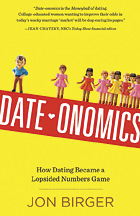When it comes to the dearth of good single men, clichés abound: a good man is hard to find, all the good ones are taken, and so on. When women complain this way, it’s easy to dismiss them as whiny, picky, or delusional. But what if the clichés are true?

The statistics are particularly dismal for educated women who hope to marry educated men. In 2012, according to census estimates, there were 5.5 million college-educated women in the United States between ages twenty-two and twenty-nine, matched up to just 4.1 million college-educated men. The last year more men than women earned bachelor’s degrees was 1981.
It’s not just that there aren’t enough eligible men to go around, Birger argues. The lopsided ratio actually affects how both men and women behave. On college campuses with more women than men, he finds that hookups are more common than monogamy. In cities with fewer men, marriage rates are lower, because men can play the field indefinitely. As Birger sums it up, “Lopsided gender ratios turn some nice guys into monsters.”
Birger interviews daters, academics, and matchmakers throughout the country, and he draws on research conducted all over the world. But his primary focus is on the New York City dating market, and a specific subset of it at that: the high-gloss, high-achiever set that shuttles between Manhattan and the Hamptons, and who hire the kind of expensive professional matchmakers on which Birger perhaps over-relies. Women who have happily dated in different New York subcultures, let alone different parts of the country, may have trouble recognizing themselves in the types who are apparently falling all over themselves to snag the slick Wall Streeters whom Birger depicts as the hottest catches. One guy relates a story of sleeping with a random woman within earshot of his “summer girlfriend”—who took him back within thirty-six hours, because “What was she going to do?”
Still, what Birger convincingly calls a “demographic time bomb” will worry any single, college-educated woman. Acknowledging that there’s no quick fix—and that few people would choose a college or a city based only on sex ratios—he advises women who prioritize marriage to consider moving to a region with friendlier ratios (like the Mountain West), or to open their hearts to guys without a college degree.





